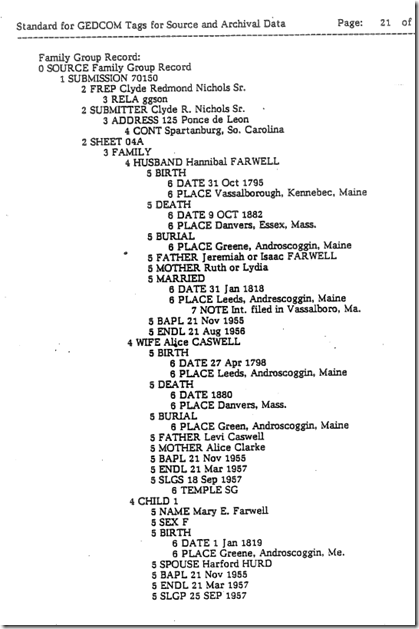Brian Madsen came through and it was worth the wait. This is the earliest GEDCOM standard yet that has been rediscovered.
Regarding the copyright, I did have an email conversation with Judy Russell, the Legal Genealogist in November 2014 about it. Her opinion to me was:
“the Church … distributed its work widely at the time, asking people to use what it was developing. It can’t now stuff the genii back into the bottle just because it isn’t currently continuing work on this. If anything, the fact that it can’t hope to profit in any way from ongoing development adds to the argument that any use of the document today — any copying or reposting — should be considered fair use. “
(and I’m really looking forward to spending time with Judy on our upcoming Unlock the Past Genealogy Cruise – which is only a week away!)
The most interesting part of the standard to me was it allowing the use of short tags or their long tag names.
Some quotes from the standard:
“These documents have been written for computer programmers, user specialists, department management, and system developers in the Family History Department of The Church of Latter-day Saints. These documents expand upon “Genealogical Data Communication: GEDCOM – A Data Format Standard” (last published in version 2.4 on 23 December 1985).”
“DISCLAIMER – GEDCOM is still quite new, and has not been exposed to demanding applications over an extended period. Refinements and enhancements will probably be needed during the next few years, which will affect implementation.”
It had a Source Record format!!!!!!!! Why was this ever removed?????
and a second example:
and a third example:
This is what I’ve been reconstituting in Behold’s Source Details section. I’ve been arguing over the past few years on BetterGEDCOM and FHISO (especially with Tom Wetmore) that this is what’s needed in a new GEDCOM standard (and not persona). Isn’t it ironic that it was in one of the early standards. I ask again, why was it taken out? It could have become the universal method of transferring sources without the need to create conclusions from them.
If you’ve followed long enough to read this far, you deserve to now get to the standard document itself, as supplied by Brian Madsen: GEDCOM 3.0 (7.3 MB)





Joined: Sat, 28 Dec 2013
3 blog comments, 0 forum posts
Posted: Tue, 9 Feb 2016
For the benefit of your readers who didn’t follow the discussions on FHISO’s list, I’ll put my two cents here. I agree with you that the source record format is needed because I was trained to work from the source material first and then extract the data from it. The extracted data, when separated for each person, is not unlike Tom’s persona — but the point of the extraction was to be able to group like ‘personas’ during data analysis while still retaining a pointer back to the source record. An ideal program (to borrow an example from the image above of printed page 21) would show me all the records which had the name Hannibal FARWELL with a display that said (n) records match MOTHER Ruth and so on. If all the records which match MOTHER Ruth and also list children of Hannibal, and none of those children are ever found in the records that match MOTHER Lydia, then it could be that the researcher has collapsed two different people named Hannibal FARWELL who both married women named Alice and has assigned the wrong maiden name to one of the wives.